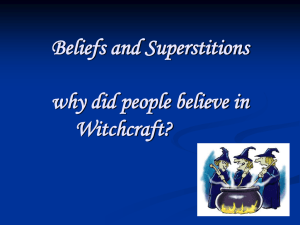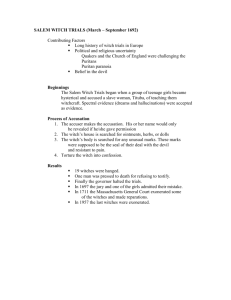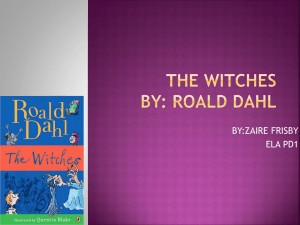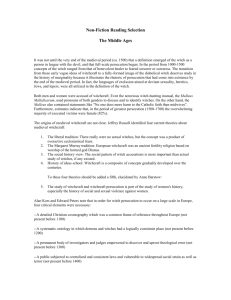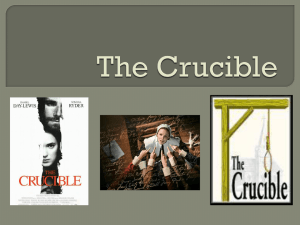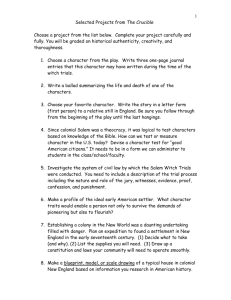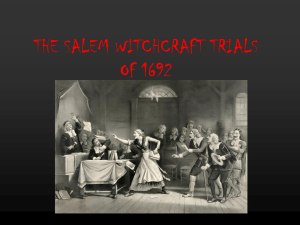A Witch Hunt: Germany 1628 Simulation
advertisement
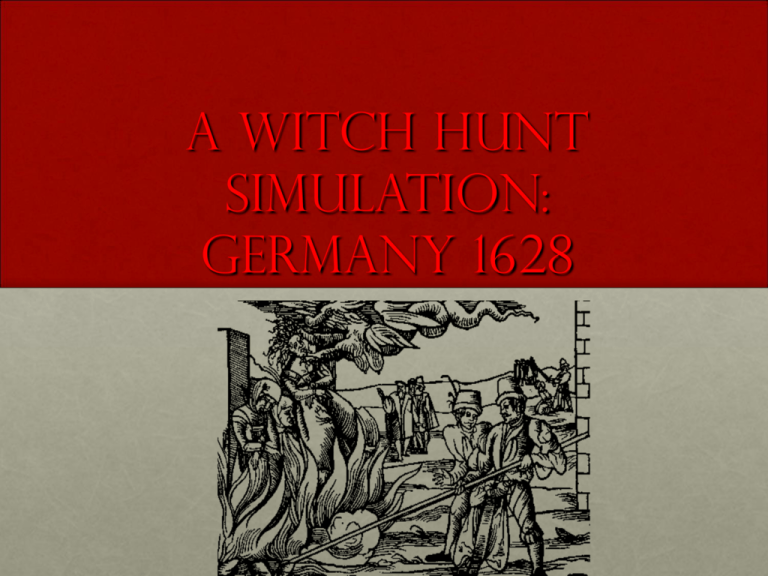
A Witch Hunt Simulation: Germany 1628 Directions • First, use the following slides on the PowerPoint to answer questions on the historical background of witchcraft. • After completing the historical background questions, complete the witch hunt simulation. Witch Scare Time • During the Reformation and Religious Wars (from 1560-1660) the practice of witch hunting escalated to alarming rates, touching every part of Europe from Ireland to Russia. Scholars currently estimate that during the 16th and 17th centuries between 100,000 and 200,000 people were officially tried for witchcraft, and between 50,000 and 100,000 were executed. What was a “witch”? • “A witch,” according Chief Justice Coke of England, “was a person who hath conference with the Devil to consult with him or to do some act.” This definition by the highest legal authority of England demonstrates that educated was well as ignorant people believed in witches. • Witches were thought to be individuals who could mysteriously injure other people or animals- by causing a person to become blind or impotent, for instance, or by preventing a cow from giving milk. Belief in witches began long before Christianity. For centuries, talks had circulated about old women who made night time travels on greased broomsticks to sabbats, or assemblies of witches, where they participated in sexual orgies and feasted on the flesh of infants. In the popular imagination, witches had definite characteristics. The vast majority were married women or widows between 50 and 70 years of age, crippled, with pockmarked skin. They often practices midwifery or folk medicine, and most had sharp tongues and were quick to scold. Church illustration of a witch’s sabbat What Caused the Increase in Witch Hunts? • The religious reformers who broke from the Catholic Church during the Reformation held extreme notions about the Devil’s powers. Also, the insecurity created by the religious wars contributed to the growth of the belief in witches. Picture of Satan’s Court from the 1200s Cause: The Consequences of the Reformation • Some scholars see witch hunts as a consequences of the Reformation: rulers proved their piety and religious commitment either by fighting religious wars (between Catholics and Protestants) or by cracking down on persons considered social delinquents. Cause: Demographic Changes • Demographic changes are changes in the population. During the 1500s and 1600s people began to marry later and there was an increase in the number of women who did not marry at all, women who were not under a man’s supervision became highly suspicious. Cause: Socioeconomic Factors • During the fifteenth and sixteenth centuries, there was severe inflation, periodic famines due to poor harvests, wars- causing a great increase in the numbers of beggars and homeless people. In addition, the growth of commercial capitalism began to undermine medieval communal values of reciprocity and replace them with a new individualistic ethic based on private property and profit. All of these developments created an atmosphere of fear and instability in which the poor were seen as threats, as agents of the devil. Some scholars believe that these fears caused people to accuse others of witchcraft. Women and Witchcraft • The great European witch scare reveals something about contemporary views of women. Given the broad feelings of misogyny (meaning hatred for women) in Western religion, the long-held belief that women were more susceptible to the Devil, and the belief that women were sexually insatiable, is the primary reason why more women were accused of witchcraft. As the most important capital crime (meaning a crime punishable by death), witchcraft has considerable significance in women’s history. Why did the Craze End? • Witch hunting declined only in the 18th century, when the Enlightenment began- this was a movement that stressed logic and science as a means of understanding the world. The Enlightenment, beginning in the late 1680s, suggested that there was no real evidence that alleged witches caused real harm, and taught that the use of torture to force confessions was inhumane. Once the educated ruling class started to doubt witches, the craze began to end. Witch Hunt Simulation • Go to http://departments.kings.edu/womens_history/witch /hunt/index.html • Complete the simulation and answer the questions that follow.
